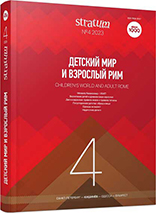Образ жизни детей и взрослых варварской округи Херсонеса (по материалам могильников Фронтовое 3 и Киль-Дере 1)
The Lifestyle of Children and Adults in the Barbarian Environ of Chersonesos (Based on Materials from Frontovoe 3 and Kil-Dere 1 Necropolises)
Author(s): Maria V. Dobrovolskaya, Natalia G. Svirkina, Sergey V. Yazikov, Alexey N. SviridovSubject(s): History, Archaeology, Social history
Published by: Издательский дом Stratum, Университет «Высшая антропологическая школа»
Keywords: bioarchaeology; Northern Black Sea region; Roman times; isotope analysis; mobility; diet;
Summary/Abstract: The necropolises Frontovoe 3 and Kil-Dere 1 from the environ of Chersonesos are interesting and important for the reconstruction of the cultural and historical situation on the borders of the Roman Empire. Data on the isotopic composition of bone collagen and tooth enamel provide new opportunities to discuss the nutrition, economy, and mobility of societies. The isotope composition of carbon and nitrogen informs about the average dietary intake of an individual over the last few years of life (7—10), while the ratio of strontium isotopes in tooth enamel characterizes the habitat of the child during the formation of the crown of the teeth (in this case, from 1 to 6 years). Thus, we obtain information about local natives and migrants of the first generation, whose childhood, probably, passed outside the environ of Chersonesos. The isotopic composition of carbon and nitrogen in 67 samples of bone tissue and the composition of strontium in 35 samples of tooth enamel were studied. The life support system of these societies was based on the use of local terrestrial food resources. Few individuals have been found who can be named first-generation migrants. The low variability of the isotope ratios of strontium and carbon indicates a clear localization of this population group on the given territory. We also discuss the factors behind the differences in the isotopic markers of groups from Kil-Dere 1 and Frontovoye 3. These can be both environmental factors and cultural differences. The questions addressed here can be answered by studying a broader base of the compared materials.
Journal: Stratum plus. Археология и культурная антропология
- Issue Year: 2023
- Issue No: 4
- Page Range: 139-154
- Page Count: 16
- Language: Russian

